Zermatt Marathon - 2nd July 2016
| In the lap of the Alps, Zermatt is a beautiful touristic Swiss town and it is well known for it’s chalets, skiing slopes, narrow lanes and now even for the Alpine goats. In the summer months, this Zermatt valley with the majestic Matterhorn in it’s background is a well sought-after region by the trekkers. Whether winter or summer, Zermatt is in a way a “Let’s Go” destination and the town administration has learnt ways to entertain the tourists. |
 Left pic- March-past by Alpine goats in Zermatt.
|
| In the summer, the biggest attraction is the Zermatt marathon. In 2016, this marathon was held on 2nd July. The race started from St. Niklaus (@1116 m), the half way mark (21.2 km) was in Zermatt (@1616 m), and the finish line for 42.2 km was in Riffelberg (at 2585 m). The tough ascent starts only after Zermatt- after 21.2 km and that’s cruel - isn’t it? |
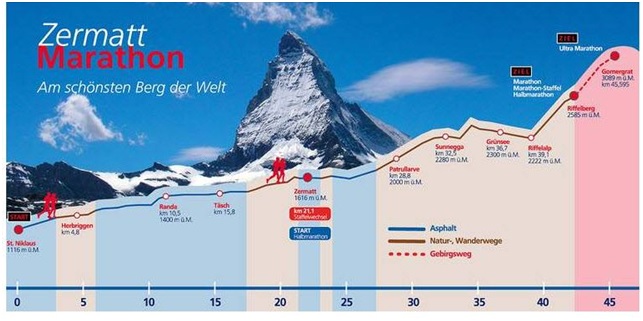 The full marathon - from St. Niklaus (@ 1116 m) to Riffelberg (@ 2585 m)The Zermatt marathon offers two possibilities - either to go for 42.2 km or for the stronger legs, lungs and an ultra-strong head there is the option of 45 km. I was told that these additional 3 km take an extra 1 hr as the stretch involves a steep ascent and the air gets thinner. When I registered, it was clear to me that I would try to attempt the 42.2 km. This distance plus the altitude was in itself a big challenge for me. However, before the race day when I was in St. Niklaus to collect my start number- I had a crazy thought, which isn’t a rare phenomenon- Why haven’t I registered for the 45 km? On seeing the ultramarathon runners (I could identify them from their red color bibs), I thought: “If they are crazy, so am I”. But the fact was: Most of these ultra-runners weren’t there to just try it out, they were actually a bunch of well-trained mountain runners. This, I only realized after completing the race. |
|
Training After the Zurich Marathon in April 2016, I had 2 months to prepare for this race. However, the training could not be one meant for street marathons. It was a mountain race with a total gain in height of 1944 meters. Since the stretch included running/walking on asphalt, stones, big and small rocks, uneven surfaces, I tried to include (as far as possible) all these surfaces in my training runs. And of course, I did some hill training. If you ask me whether I like hill training, my answer is NO. When I run up the hill, I feel my lungs would pop-out of my mouth. 2 weeks before the race day, I did my longest hill training run. It was a 31 km run which included running from the city of Zurich (@ 400 m) up to the Uetliberg (@ 800 m) and then down to the city, and then repeating it all over again. That day, I did almost 1000 m of uphill training. My entire training went injury-free and this was most important to me. On the days I did not run, I cross-trained on my cycle, which meant biking 7.5 km to work and back. A good way to save some travel money and to stay away from the smart phone. 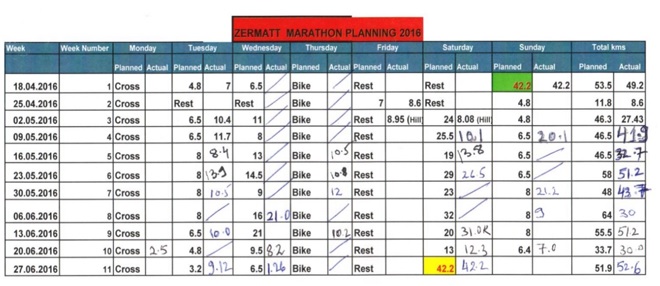 Zermatt Marathon training plan. The green represents the day of Zurich marathon and yellow is the day of Zermatt marathon |
| The day before the race On the evening of 1st July with the 5pm train from Zurich main station, I travelled to St. Niklaus. I changed the train in Visp. From Visp to St. Niklaus there was a random party in the train. With me boarded a group of musicians, they were getting ready to boost the spirits of the marathon runners. This part of the journey was loudly musical. I reached St. Niklaus around 7:30 pm. It was late, so I rushed to pick my start number. The pick-up area was not that far. Once I received my start number, I boarded the next train to Zermatt to attend the pre-race pasta party. I reached Zermatt and the first thing I did was to have a big plate of pasta. But one was not enough. A 42.2 km run with 2000 meters of ascent to cover was coming up. I had to carb load myself with another plate. That’s why they say: “Guys who do sports do not eat mindfully” but I would say: “If you love pasta, you better do sports” |
| The race day At night when I reached the chalet, I knew the start line was close. But little did I know that it was barely 100 meters away. Never ever had I spent a night so close to the start line. In other words, I almost slept on the start line. It was almost like starting the marathon from your bed. If you ever want to run the Zermatt race, I would really recommend this Chalet Isabelle in St. Niklaus. The race started at 8:30 in the morning. Sharp. 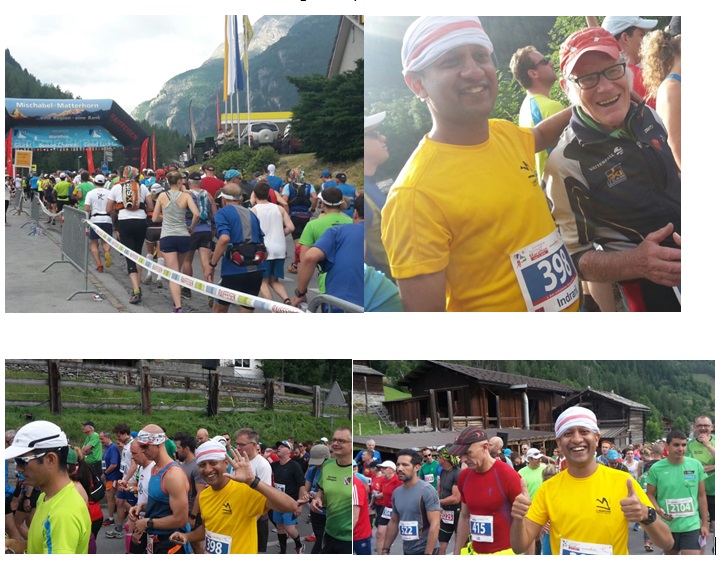 At the start with Christoph Geiger, the 74-year-old ultramarathon runner, and many others |
| At the start line, we were a mix of marathon, ultramarathon and half marathon runners. The first part of the race towards Zermatt was relatively flat. I knew that the latter part after Zermatt would be stubbornly uphill and all I could do there was to walk. So I kept up with my pace in the 1st half of the race, whenever it was possible. That was my trick with mountain running: “Increase the pace when it was flat. But that didn’t mean to go all guns out as it was equally important to preserve energy for the uphill cruel stretch.” As the race started, in the initial stretch, there was one jam after the other. This was the first time I experienced “runners jam”. Too many runners were trying to pass through the narrow streets and through the narrow stretches of wood. Once the initial congestion eased, the race re-started. We ran through woods, open fields and along the railway tracks heading towards Zermatt. As the trains from St. Niklaus passed us, friends and relatives of runners cheered and waved at us from the train. It was like audience on wheels. Mountains races do have scattered spectators support as compared to city marathons. Therefore, each cheering counted and boosted my and the morale of other runners. As we ran through the small villages of Randa and Täsch - the residents clapped, shared high-fives and gave the much-needed mental boost. Weather-wise, it was a perfect day to run with an overcast sky. This phase was relatively easy and each runner (probably) knew that the challenge was yet to come after Zermatt. Sound and music from far was filling the air, I knew I was approaching Zermatt - the half way mark. It was comforting and the comfort increased as I saw the valley from a distance. I crossed the 21.2 km in 2h 11min, which included a gain in height of 500 meters. 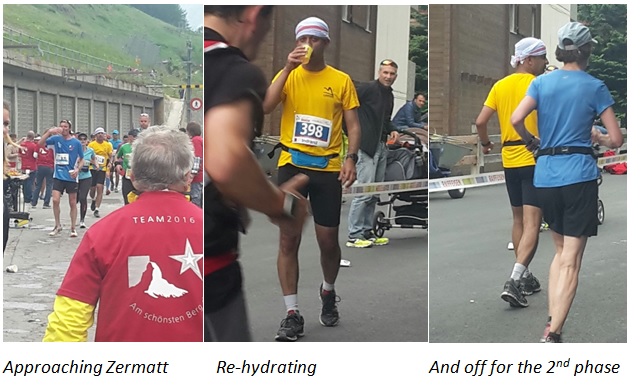 After passing the Zermatt, the next stretch was a killer. I had only seen the route on the map but now I was experiencing it. Whenever it was flat, I ran but most of the stretch I walked. Sometimes when it was downhill, I ran but I had to be careful of the cramps and not to slip off the stones and rocks. 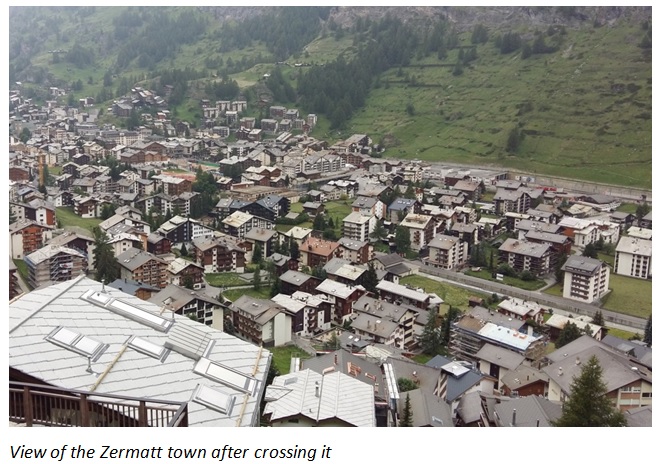 With more difficulty than easiness in 3h 56 min, I reached Sunnegga, which was the 32 km mark. As I approached, the beautiful sight of the lake and the mountains welcomed me. This gave a breeze of fresh energy and comfort after the hard running.  Look here for the video at Sunnega : Link to video 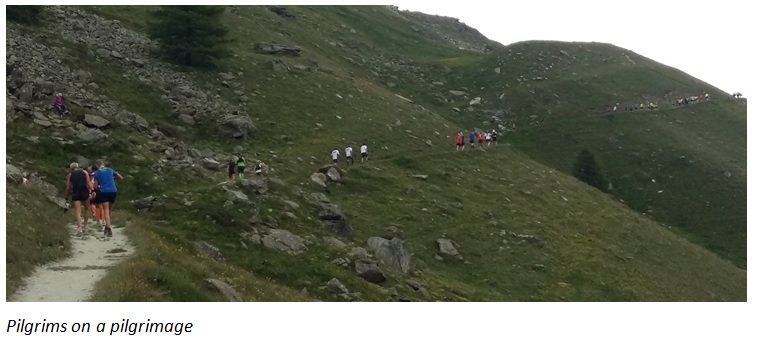 There were 10 more kilometers until the finish line. From Sunnegga to Riffelalp were 7 kilometers and there wasn’t much of an ascent. However, after Riffelalp, the last 3 kilometers to Riffelberg included a killer rise of 363 meters and this had to be accomplished to complete the race. So at this stage, when the body is all dropping and tired, all that could carry you to the end is YOU and some positive words from co-runners, who were also tired. I completed these 3 kilometers in 57 minutes. Yes, it took ages because I walked all the way holding my cramped quadriceps. |
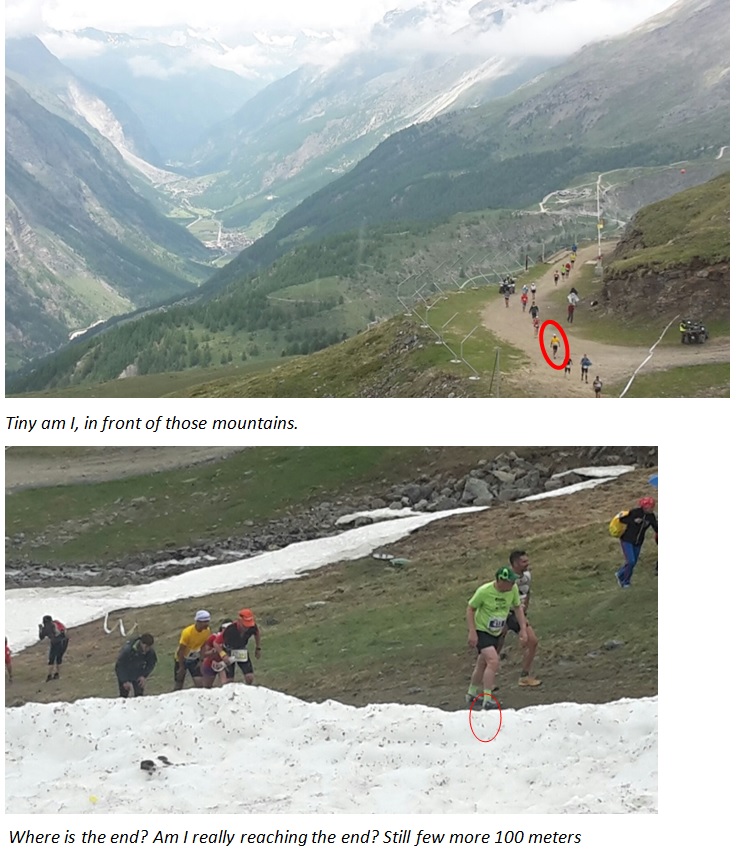 And finally after the last climb, I saw the finish line. But to cross it one had to take a long last round. Oh no! I hated the race organizers. But this was for us, who were concluding the 42.2 km pilgrimage. And for those who were on for the 45km challenge, they had to do 3km more with a rise of 500 meters. Respect for those who went on to complete the ultramarathon. At this moment I thought: Oh! it was such a good idea to stick to 42.2 km. I could hardly do the marathon and a day before I was thinking of running the 45 km. Sometimes, I do take good decisions. 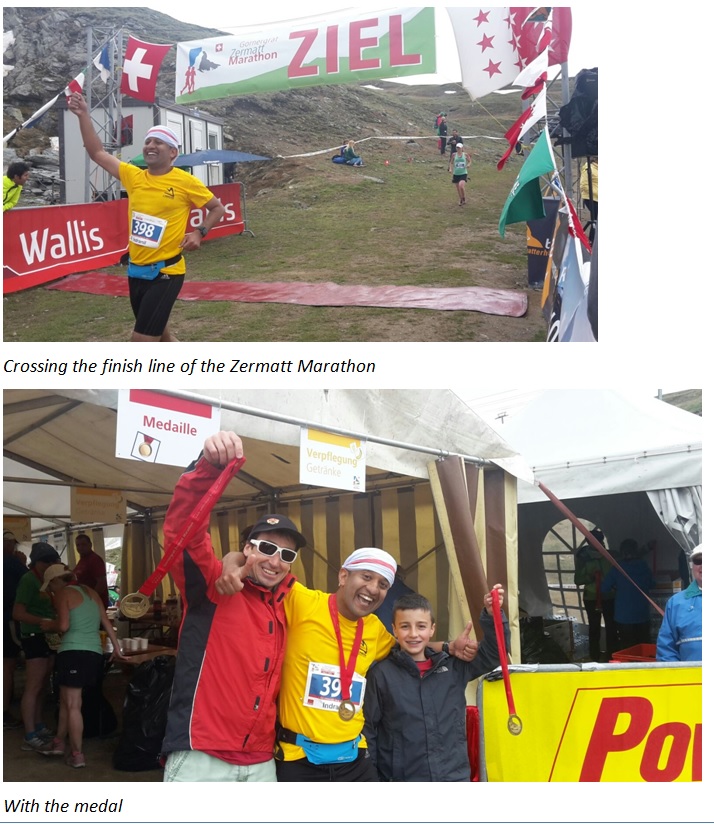 As I crossed the finish line after 5h 58 min, there were two guys waiting for me with a medal. I chose to take it form the the kid, instinctively. And before I received the medal, I gave a hug to both guys. Running this distance had suddenly made me so humble, which I am generally not. This race was done. I finished the Zermatt marathon. My 7th marathon. After a warm shower, it was time to pose with the finisher’s T-shirt. Proudly. |

|